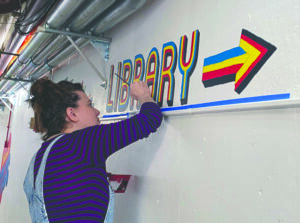
By Precious Kenney
The Scene staff
Big, bold, colorful murals have popped up on walls throughout the basement level of Forest Park this semester.
A closer look reveals images within images, including the St. Louis Community College logo, its sports mascot, Archie the Fox, and other characters that reflect campus culture.
“It spells out some fun things down there,” said President Julie Fickas, one of about 50 volunteers who painted portions of the murals.
“It also talks a lot about who we are. You get to see a little bit about the books down there, you see a little bit about the energy that we have here and what our campus is all about. You see the frog reading, you know, he’s studying. So there’s little bits and pieces, and (there’s) a little bit of whimsy, too.”
Images range from a giant butterfly to a rat holding a rainbow-colored umbrella. A 7-foot-tall robot has an actual Exit sign for a head.
The 10 murals were designed in 2022 by a committee of faculty and student artists, led by Norleen Nosri, fine arts program coordinator.
Fine arts major Kayla Bailey, 38, former vice president of the Clay Club, “revolution She used the digital software Procreate to transform sketches into simple, cohesive images that could be projected on concrete-block walls, traced and painted in color-by-numbers style.
“When you walk down the hallway now, it kind of looks like they go together, even though they’re all designed by different people,” Bailey said.
Nosri added an interdepartmental flavor by bringing in Karana Phillips, chair of computer and information technology and program coordinator of database, software and web development. Her goal was to make the murals more interactive and engaging.
Students, faculty and staff did the painting this winter. They used Sherwin Williams house paint in all primary colors.
The volunteers included Vienna Sowell, 20, a general studies major who works in the art annex. She heard about the project through Bailey.
“I mostly helped out with just the actual painting,” Sowell said. “I would go over and hang out with Kayla while the volunteers were there, or before, or after I would do the linework.
“Most of it was pretty easy because it was Kayla who would draw up the outlines. We would tape colored pictures next to the murals so you could see which sections needed to be what color and easily figure that out.”
Murals are works of art that can span a wall or an entire hallway and often represent their communities.
The idea for the mural project at Forest Park originated with a student in 2022.
“We had talked about similar ideas in the past,” Fickas said. “But a student came and made an appointment with me and said, ‘Hey, I have something that I’d like to bring to you to improve the campus, and I think that basement wall is so blank and plain, and it’s boring and it needs something.”
It was Fickas who asked Nosri to oversee the mural project. The Campus Improvement Committee and College Cabinet made suggestions and ultimately approved the designs.
The basement level of Forest Park, also known as O Level, includes tunnels that lead to the automotive technology department, the theater building and former health science classrooms.
One goal of the mural project was to make the basement friendlier, less “dingy” and more inviting, according to Nosri. However, she has a soft spot for the industrial look.
“The word beautiful is so difficult,” Nosri said. “Maybe we should just embrace what it is down here. What’s wrong with the inner workings of the building? To us artists, I see there’s potential here. … It’s just fantastic.”
Artists that inspire Nosri include Hayao Miyazaki, a Japanese animator, and Banksy, an unkown graffiti artist, for the way they incorporate their surroundings into their work.
The design committee for the Forest Park murals chose primary colors for efficiency and cost effectiveness.
Bailey came up with the idea to incorporate directional signs when a student asked her where the library was located. A squirrel perched on the robot’s elbow was patterned off a real-life squirrel she saw scurrying along pipes one day.
Most of the volunteer painters weren’t artists per se. Nosri and Bailey worked to provide them with a good experience and make them feel like they were contributing to campus beautification.
“They can walk by and be like, ‘It’s different now. It’s not that cringey place. This is where I hung out and painted with my community,’” Nosri said.
Murals from page 1 Fickas also was looking for ways to “invite people into the work.”
She praised art faculty for making the mural project happen, noting it was more difficult than it looked.
“They were very, very thoughtful in how they did those things, taking these brainstormed beautiful ideas to tell the story down in the basement the way they did, and then making it into something that others could participate in … (That) was just amazing to me,” she said. “So, kudos to the faculty and students who did the incredible work to make it so that we could participate in the art”
